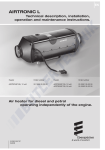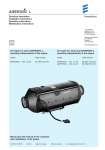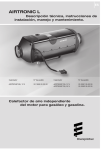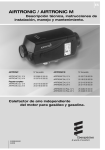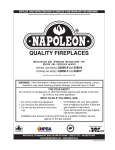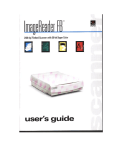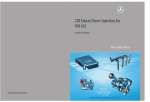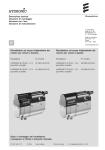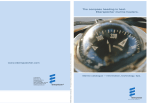Download Eberspracher Airtronic D2 Operating instructions
Transcript
AIRTRONIC D2 / AIRTRONIC D4 Troubleshooting and repair instructions Eberspächer ® J. Eberspächer GmbH & Co. Eberspächerstr. 24 D -73730 Esslingen Telefon (zentral) (07 11) 9 39 - 00 Telefax (07 11) 9 39 - 05 00 www.eberspaecher.com Valid for the following heater versions: AIRTRONIC D2 AIRTRONIC D4 25 2069 05 00 00 - 12 volt 25 2115 05 00 00 - 12 volt (complete package) 25 2113 05 00 00 - 12 volt 25 2070 05 00 00 - 24 volt 25 2116 05 00 00 - 24 volt (complete package) 25 2114 05 00 00 - 24 volt 25 2069 95 13 30 09.2001 Subject to change Printed in Germany 1 © J. Eberspächer GmbH & Co. Contents Page Important information prior to any work Areas of use of the AIRTRONIC ........................................ 2 Content and purpose These instructions serve to eliminate any malfunctions and to carry out repairs on the AIRTRONIC. Any work necessary for this may only be carried out by appropriately trained staff at an Eberspächer service partner. Statutory regulations and safety instructions for the installation and repair of the AIRTRONIC ............. 3 Sectional drawing ............................................................. 4 Function ............................................................................ 5 - Switching on / off the AIRTRONIC - Start the AIRTRONIC - Temperature selection with the control element - Control in heating mode - Fan mode - Model GGVS / TRS 003 / ADR / ADR 99 - Heating operation at high altitudes Further documentation of the AIRTRONIC These instructions contain all the necessary information and instructions to repair the AIRTRONIC. If a spare part is required as a result of a repair, this part must be ordered from the spare parts list. If necessary, the technical description / installation and operating instructions may be used. Prevention of accidents and important information The general accident prevention regulations and relevant operational safety instructions always have to be complied with. For further information, please refer to page 3. Controls and safety devices ............................................. 6 Forced cut-off in GGVS / TRS 003 / ADR / ADR 99 mode .. 6 Environmental protection Eberspächer is accepting the challenge and actively participates in avoiding and removing any ecological problems. Our course of manufacture has been certified in accordance with ISO 9000 (quality management) and with ISO 14001 (environmental management). In addition to ISO 9000, Eberspächer has also been certified in accordance with QS 9000 (extended quality management of the American motor car industry of the manufacturers Ford, GM and Chrysler) as well as in accordance with VDA 6.1 (extended quality management of the German motor car industry). In the event of a malfunction, check the following points ................................................. 6 Diagnosis with integrated module clock .......................... 6 Checking the control unit (rotary potentiometer) ............. 6 Function diagram .............................................................. 7 Technical data .................................................................. 8 Control values ................................................................... 9 Fault diagnosis with the module clock ............................ 10 Testing the operator control unit ...................................... 11 Disposal Disposal of materials: Old devices, defect components and packaging material must all be subjected to pure-grade sorting so that all parts can be disposed of in an environment-friendly manner or, where possible, recycled. Electric motors, controllers and sensors (e.g. temperature sensors) are to be considered as “electronic scrap”. Dismantling the heater: The heater is dismantled in accordance with the repair steps described in these instructions. Packaging: The heater packaging can be kept for possible return. Fault codes / Description of fault ............................. 12 – 15 Circuit diagram AIRTRONIC D2 / D4 ........................ 16, 17 Circuit diagram control elements – part 1 ....................... 18 Circuit diagram control elements – part 2 ....................... 19 Circuit diagram AIRTRONIC D2 / D4 – GGVS / TRS 003 / ADR / ADR 99 ................................ 20, 21 Circuit diagram control elements – GGVS / TRS 003 / ADR / ADR 99 ................................ 22, 23 Repair instructions ................................................... 24 – 31 Measuring the fuel quantity ............................................. 32 Area of use of the AIRTRONIC Taking into consideration their heating capacity, the stationary and auxiliary heaters ‘AIRTRONIC’ are intended for installation and use in all types of motor vehicles and their trailers, in construction machines, machines used in agriculture, in boats, ships and yachts for the purpose of preheating, clearing of window panes, heating and keeping warm of driver’s or working cabs, cargo compartments, ship’s cabins, passenger or crew transport spaces, engine motors and aggregates. The AIRTRONIC is suitable for use and permitted to be installed in vehicle spaces used by passengers and to be installed into vehicles used to transport dangerous substances corresponding to the regulations in accordance with GGVS / TRS 003 / ADR / ADR 99 (detailed information in this regard is contained in an information sheet with the print No. 25 2069 95 13 50). When installing the device for the purpose of cargo compartment / cargo heating, the standard AIRTRONIC controller has to be exchanged against the corresponding TRS 003 controller (see heater price list or spare part list). However, it is not permitted to be installed in the driver’s cab or passenger compartment of coaches with more than 9 seats. The ‘statutory regulations’, ‘safety instructions’ and ‘important instructions’ relevant to the installation and printed below in these troubleshooting and repair instructions, and which govern the equipment selection, area of use, installation and operation of the AIRTRONIC must be taken into consideration. Based on its functional purpose, the AIRTRONIC is not permitted to be used for other areas of use apart from those listed, in particular not for a long-term continuous operation, e.g. to preheat and heat living spaces, garages, working huts, week-end homes, hunting lodges, houseboats or similar as well as not to heat up or to dry objects or living beings (man or beast) by directly blowing hot air onto them and / or blowing hot air into appropriate receptacles. 2 § Statutory regulations for the installation and repair of the AIRTRONIC ! • For installation in motor vehicles subject to the Regulations authorizing the Use of Vehicles for Road Traffic (StVZO), the air heater has been approved by the German Federal Office for Motor Traffic in keeping with the ‘General Design Certification’ (AGB) and the official test symbol is marked on the type plate of the heater. AIRTRONIC D2 AIRTRONIC D4 Safety instructions concerning the installation and repair of the AIRTRONIC Danger of burns and injury! Before commencing any work on the AIRTRONIC, disconnect the vehicle battery. The AIRTRONIC may only be started up if the top shell and the exhaust hood have been mounted in accordance with the regulations and if the air duct on the suction and heating air side has been carried out in accordance with the regulations. S 318 S 323 • The mounting requirements associated with the General Design Certification (AGB) and further statutory regulations have been printed in the corresponding sections of these mounting instructions. • When the air heater is installed in special vehicles, the regulations governing such vehicles must be taken into account (e.g. GGVS / TRS 003 / ADR / ADR 99 for vehicles used to transport dangerous substances). • The year in which the air heater was operated for the first time must be permanently recorded on the type plate. To this end, 3 different years have been printed on the corresponding field of the type plate. The valid year is to be identified by removing (detaching) those two years which are not applicable. • Subsequent installation of the heater must be carried out in conformity with these mounting instructions and must be examined and certified in writing by an officially approved vehicle specialist or inspector or employee (Section 4 of Annex VIII b to the StVZO) in conformity with § 19 Section 3 StVZO. The effectiveness of the design certification (ABG) for the heater is dependent on this. At the discretion of the vehicle owner, the certificate can be issued as follows: – As separate ‘Certificate of Approval’ which must always be kept in the vehicle. A blank form for this ‘Certificate of Approval’ is attached at the end of the operating instructions for the heater. Neutral certificates of approval available to the motor vehicle specialist are also permissible. In both cases, the vehicle manufacturer, vehicle model and vehicle identification number must be entered. – As entry in the vehicle registration document (assessing authority) and in the vehicle identification card (licencing authority.) • For vehicles not subject to the StVZO (e.g. ships), it is necessary to observe the specific regulations and mounting instructions applicable to the given vehicle; these may difffer regionally. • The heater may only be installed or repaired – in case of the heater being handed in for repair or guarantee reasons - by a specialist workshop approved by the manufacturer (service partner) in keeping with these mounting instructions and possible special installation recom-mendations. • The information sticker ‘Switch off heater before refuelling’ suppplied with the heater must be attached in a suitable position on the vehicle (close to the fuel filler neck). During operation, the top shell may not be opened and hot parts not be touched. ATTENTION! Important instructions for the installation and repair of the AIRTRONIC When mounting or repairing the heater, only original accessories and original spare parts may be used. Changes to the AIRTRONIC or to components relevant to the heating, the use of outside parts not approved by Eberspächer as well as an installation or operation differing from the statutory, safety and / or function relevant specifications contained in the mounting instructions and in the operating instructions are not permissible: this applies in particular to the electric wiring (circuit diagrams), the fuel supply, the combustion air and exhaust gas duct. Only the control elements provided and / or approved by us, either on their own or in a given combination, may be used to operate the AIRTRONIC. The use of other control elements may lead to malfunctions of the heater / heating operation. Non-compliance with the statutory, safety and / or function relevant specifications may lead to the lapse of the General Design Certification (ABG) of the AIRTRONIC and to the exclusion of guarantee and liability on the part of the company J. Eberspächer GmbH & Co. Please note! Further ‘Safety instructions concerning the installation and repair of the AIRTRONIC’ as well as ‘Important instructions concerning the installation’ have been printed directly in the corresponding sections of these troubleshooting and repair instructions. 3 Sectional drawing 1 2 3 4 5 6 7 8 9 10 11 12 13 14 15 Hot-air impeller Control unit Combustion air impeller Glow plug Cover Heat exchanger Combi-sensor (overheating sensor / flame sensor) Module clock Change-over switch ‘heating / ventilating’ Fuse carrier with master fuse and fuse ‘actuation’ Electric motor Fuel connection Flange seal Combustion chamber Exhaust hood AIRTRONIC D2 = Ø 60 mm or Ø 75 mm AIRTRONIC D4 = Ø 75 mm or Ø 90 mm Combustion air hose Dosing pump Cup sieve built into the dosing pump Exhaust Flexible exhaust gas pipe Exhaust silencer 16 17 18 19 20 21 F W A B V 4 = = = = = fresh air hot air exhaust gas fuel combustion air function Function fan will continue to run for approx. 4 minutes to allow the heater to cool down. Afterwards the fan will continue to run at the slowest speed (recirculation mode) or will be switched off (fresh air mode) until a renewed start of the heater. Initial start-up If the AIRTRONIC has been properly installed in accordance with the installation instructions and if the fuel supply system has been carefully deaerated, the initial start-up may commence. Switch on the AIRTRONIC at the control element. During the trial run of the AIRTRONIC, all connections and the entire heating system have to be checked for air-tightness and tight fit. Should the AIRTRONIC indicate a malfunction, trouble shooting as described on page 6 must be carried out. Fan mode To start the AIRTRONIC in fan mode, the change-over switch ‘heating / ventilating’ needs to be actuated first before the heater is switched on. Switching off As soon as the AIRTRONIC is switched off, the pilot lamps go out and fuel pumping is switched off. The fan will continue to run for approx. 4 minutes to cool down the heater. For cleaning, the glow plug is switched off for 40 seconds (AIRTRONIC D2) and 30 seconds (AIRTRONIC D4) while the fan is still running. Special case: If no fuel has been delivered until switch-off, or if the AIRTRONIC is set to the ‘OFF’ control level, then the AIRTRONIC is stopped without the fan continuing to run. Switching on The pilot lamp in the control element lights up when the heater is switched on. The glow plug is switched on and the fan will start running at a low speed. Please note! If there is still too much residual heat in the heat exchanger from a previous heating operation, first only the fan (cold blowing) will run. The heater will only start once all the residual heat has been dissipated. Start AIRTRONIC D2 Fuel starts to be delivered after approx. 60 seconds. The fuel-air mixture in the combustion chamber ignites. Once the combi-sensor (flame sensor) has detected the flame, the glow plug is switched off after 60 seconds. After another 120 seconds, the AIRTRONIC has reached the control stage “POWER” (maximum fuel quantity and maximum fan speed). Model GGVS / TRS 003 / ADR / ADR 99 The AIRTRONIC is GGVS / TRS 003 / ADR / ADR 99 suitable. If, in conformity with StVZO (D), the AIRTRONIC is to be built into road tankers used to transport dangerous substances for the purpose of heating the driver’s cab, the GGVS / TRS 003 / ADR / ADR 99 regulations have to be complied with. (More detailed information regarding the GGVS / TRS 003 / ADR / ADR 99 regulations can be found in the information sheet with the print No. 25 2069 95 13 50). When installing the device for the purpose of cargo compartment / cargo heating, the standard AIRTRONIC controller has to be exchanged against the corresponding TRS 003 controller (see heater price list or spare part list). For the wiring, refer to the circuit diagram on pages 20 – 23. AIRTRONIC D4 Fuel starts to be delivered after approx. 60 seconds. The fuel-air mixture in the combustion chamber ignites. Once the combi-sensor (flame sensor) has detected the flame, the glow plug is switched off after 80 seconds. The AIRTRONIC is in the control mode. Temperature selection with the control element The desired indoor temperature is preselected with the rotary control switch. Depending on the heater selected, on the size of the room to be heated and on the prevailing outdoor temperature, this value may range between +10 °C and +30 °C. The control switch setting to be selected is an experimental value. Heating operation at high altitudes • Up to 1500 m: Unrestricted heating operation is possible. • Above 1500 m: Heating operation is in principle possible for short periods, e.g. when crossing a mountain pass or during a brief stop. In case of extended stays (e.g. winter camping), the fuel supply has to be adapted to high altitude conditions. Please consult the responsible regional sales agency. Control in heating mode In heating mode, the room temperature and the temperature of the heating air taken in is continuously measured. Control commences if the temperature exceeds the temperature preselected on the control element. 4 control levels have been provided for so that the heat flow supplied by the heater can be accurately adapted to the heating requirements. Each control setting has its own fan speed and fuel quantity. If the adjusted temperature is even exceeded at the lowest control level, then the AIRTRONIC is adjusted to the ‘OFF’ control level and the 5 Control and safety devices In the event of a malfunction, check the following points • If the AIRTRONIC does not ignite within 90 seconds after fuel pumping has started, then the start is repeated in the manner described. A malfunction cut-off is effected if after a further 90 seconds of fuel pumping the AIRTRONIC once again fails to ignite, i.e. fuel pump switches off and the ventilator continues to run for approx. 4 minutes. If the AIRTRONIC does not start when it is switched on: • Switch off the AIRTRONIC and then switch it back on again, but no more than twice in succession. If the AIRTRONIC still does not start, then check: • Is there fuel in the tank? • If the flame extinguishes by itself during operation, a renewed start is carried out first. If the AIRTRONIC fails to ignite within 90 seconds after fuel pumping has started again or if it does ignite but then extinguishes itself within the next 15 minutes, a malfunction cut-off is effected, i.e. fuel pump switches off and the ventilator continues to run for approx. 4 minutes. It is possible to override a malfunction cut-off by briefly switching the heater off and on again. Do not repeat this more than twice in succession! • Have any fuses blown? AIRTRONIC 12 V – main fuse 20 A AIRTRONIC 24 V – main fuse 10 A AIRTRONIC 12 / 24 V – fuse, actuation 5 A • Are all electric wires and connections ok? • Are the heating-air duct, combustion-air duct or the exhaust-gas duct blocked? • If the AIRTRONIC unintentionally remains in ‘ventilating’ mode after it is switched on, the control element has to be checked for a short circuit – compare fault description of fault code 063 in this regard. If this fault occurs, no fault code will be displayed. • In the case of overheating, the combi-sensor will respond, the fuel supply will be interrupted and a malfunction cut-off will be effected. Once the cause of overheating has been eliminated, the AIRTRONIC can be restarted by briefly switching it off and on again. If these points are OK, then proceed with a diagnosis test using the JE diagnosis unit or the module clock, and check the control unit with the corresponding testing instrument. • If the upper or lower voltage limit is reached, a malfunction cut-off is effected after 20 seconds. • The AIRTRONIC will not start if the glow plug or ventilator motor is defective or if the electrical line to the dosing pump is interrupted. Diagnosis with integrated module clock • In the case of defective combi-sensor or interrupted electric lead, the AIRTRONIC does not start and the malfunction shutdown then takes place. Proceed with fault diagnosis with the module clock, see page 10. • The speed of the fan motor is continuously monitored. If the fan motor does not start or if the speed deviates by more than 10%, a malfunction cut-off is effected after 30 seconds. Diagnosis test with the JE diagnosis unit and additional adapter cable Order no. diagnosis unit 22 1512 89 00 00 Order no. adapter cable 22 1000 31 86 00 • When switching off the AIRTRONIC, the glow plug is switched on for 40 seconds, while the fan motor is running, (afterglowing) to clean it of any combustion residues. Connection: see installation instructions included with the adapter cable. Instructions: see oeprating instructions included with the diagnosis unit. Forced cut-off in GGVS / TRS 003 / ADR / ADR 99 mode Checking the control unit (rotary potentiometer) Order no. test unit 22 1509 89 00 00 If it has been installed in vehicles used to transport dangerous substances (e.g. road tankers), the AIRTRONIC must be switched off before any hazardous area (refinery, petrol station, etc.) is entered. If this is not complied with, the AIRTRONIC will automatically shut down if: • The vehicle’s engine is turned off. • An accessory unit is switched on (e.g. auxiliary drive for the unloading pump). After cut-off, the fan will briefly continue to run for max. 40 seconds. Connection and control of the test unit see page 11. 6 Functional diagram AIRTRONIC D2 Functional diagram AIRTRONIC D4 7 Technical data Heater AIRTRONIC D2 AIRTRONIC D4 Heating medium Air Heat flow settings Step Step Power Fast Medium Slow Power Fast Medium Slow Heat flow (watt) 2200 1800 1200 850 4000 3000 2000 1000 Hot-air throughput without counterpressure (kg/h) 105 87 60 42 185 150 110 65 Fuel consumption (l/h) 0.28 0.23 0.15 0.10 0.51 0.38 0.25 0.13 34 23 12 8 40 24 13 7 Electrical input (watt) During operation 12 V and 24 V When starting 12 V and 24 V During control pause "OFF" < _ 100 <_ 100 4 to 5 4 to 5 Rated voltage 12 V or 24 V Operating range Lower voltage limit An under-voltage protecting device in the controller turns off the heater at approx. 10.5 V and 21 V 10.5 V and 21 V Response time – under-voltage protection: 20 seconds Upper voltage limit An over-voltage protecting device in the controller turns off the heater at approx. 15 V and 28 V 16 V and 32 V Response time – over-voltage protection: 20 seconds Fuel For "Fuel quality" and "Fuel at low temperatures" see Operating Instructions (page 13) Commercial diesel fuel (acc. to DIN EN 590) Permissible ambient temperature Operation –40 °C to +70 °C Storage –40 °C to +85 °C Degree of radio interference suppression 3 for UKW, 4 for KW, 5 for MW / LW Maximum air-intake temperature Weight +40 °C approx. 2.7 kg approx. 4.5 kg All technical data ± 10 % Noise emission inside the vehicle ATTENTION! Technical data specified have to be complied with in so far as this can be influenced and the minimum / maximum values may not be exceeded or fallen short of as this may lead to malfunctions of the AIRTRONIC and / or of the heating operation and / or to damage to components relevant to the heating. The highest sound pressure level is < 56 dB (A), measured in the operating setting “Fast”, inconformity with 3. GSGV and DIN 45 635 – Part 1. 8 Control values Motor speed Control stage • Power • Fast • Medium • Slow • Adjustment – in circulation mode with temperature sensor, internal – in fresh air mode with temperature sensor, external • Ventilation AIRTRONIC D2 4800 U/min ± 140 U/min 4000 U/min ± 120 U/min 2800 U/min ± 80 U/min 2000 U/min ± 60 U/min AIRTRONIC D4 4400 U/min ± 130 U/min 3600 U/min ± 100 U/min 2800 U/min ± 80 U/min 1600 U/min ± 50 U/min 600 U/min ± 20 U/min 0 U/min 4800 U/min ± 140 U/min 600 U/min ± 20 U/min 0 U/min 3600 U/min ± 100 U/min Resistance values Component Blower motor AIRTRONIC D2 - 12 V 0,6 W ± 0,1 W AIRTRONIC D2 - 24 V 2 W ± 0,4 W AIRTRONIC D4 - 12 V 0,4 W ± 0,1 W AIRTRONIC D4 - 24 V 1,5 W ± 0,3 W Glow plug 0,5 W ± 0,05 W 2 W ± 0,2 W 0,5 W ± 0,05 W 2 W ± 0,2 W Dosing pump 10 W ± 0,5 W 36 W ± 1,8 W 10 W ± 0,5 W 36 W ± 1,8 W Operator control unit set value potentiometer 1750 – 2080 W ± 80 W Switching value Component Overheating sensor AIRTRONIC D2 / D4 160 °C – 170 °C measured in the control stage "power" and at a clearance of 300 mm from the hot air outlet Exhaust value CO2 in exhaust in control stage "fast" AIRTRONIC D2 / D4 7.5 – 12.5 Vol. % Soot number as per Bacharach <6 Temperature sensor, tested externally Values table temperature sensor, external Test the external temperature sensor with a digital multimeter. If the resistance value is outside the set point indicated in the values table, then replace the external temperature sensor. Temperature °C 0 5 10 15 20 25 30 35 40 45 2400 Resistance (Ohm) 2200 2000 1800 1600 1400 1200 1000 –40 –30 –20 –10 0 10 20 Temperature (°C) 30 40 50 9 Resistance W min. 1600 1670 1745 1820 1895 1970 2050 2130 2210 2295 max. 1660 1730 1800 1870 1950 2030 2110 2190 2280 2370 Fault diagnosis with the module clock If the controller has detected a fault when the heater is turned on or during heater operation, then the module clock will indicate the fault within 15 seconds as F with a 2-digit number. Example: F 64 (= current fault) and flashing heating symbol. For fault code, description of faults and remedies, please see pages 12 – 15. 1 2 3 Timer Preselection Heating 4 5 6 Backwards Forwards Display with fault indication Interrogating the fault memory in the controller Deleting the fault memory The electronic controller can store up to 5 faults which can then be read-out and displayed on the module clock. The current fault is moved to memory location F1. Previous faults are moved down to the memory locations F2 to F5. Precondition: There is an electrical connection from terminal 15 (ignition) to the module clock, 12-pin connector, chamber 10. Press the c key. The current fault F 15 or F 50 is displayed. Then press the a key, hold it and press the p key within 2 seconds. The module clock is now in the program “interrogate fault memory”. Continue operation: Turn off the ignition (terminal 15). Press the a key and the p key at the same time, then turn on the ignition (terminal 15) and wait until the following appears on the display: Interrogating the fault memory with module clock Press the c key. The heater is turned on. Then press the a key, hold it and press the p key within the next two seconds. The current fault will then be displayed, e.g. F : 64. The stored faults (maximum 5 faults) can be called with the e and F keys (max. 5 faults). For fault code, description of faults and remedies, please see pages 12 – 15. Display after ignition “ON” Interrogating the fault memory with module clock, for vehicles used to transport dangerous goods as per GGVS / TRS 003 / ADR / ADR 99 The controller is unlocked after 3 seconds, then the heater starts. Display after heater starts Press the c key, the p key and the a key at the same time, the AIRTRONIC can be switched on, the current fault is indicated. The stored faults (maximum 5 faults) can be called with the e and F keys (max. 5 faults). flashing display heating symbol does not flash Display: currently no fault, heating symbol Please note! If the AIRTRONIC is not operated with the module clock, then fault code interrogation is possible with a diagnosis instrument and an additional adapter cable. Order no. diagnosis instrument Order no. adapter cable 22 1512 89 00 00 22 1000 31 86 00 Connection see installation instructions included with the adapter cable. Operation see operation instructions included with the diagnosis instrument. 10 Testing the operator control unit Order no. for the testing instrument – operator control unit 22 1509 89 00 00 Before testing Connect the right operating voltage (12 or 24 volt) to the testing instrument with plus connected to the red socket and minus to the blue socket. • Disconnect the connector from the operator control unit. • Connect the cable from the testing instrument to the operator control unit. • Set the rotary knob on the operator control unit to “heating”, the corresponding red LED on the testing instrument must light up. • Set the operator control unit to “0”, then press the “LED red” button, the red control lamp on the operator control unit must light up. • Set the operator control unit to “heating”, then press the “LED green” button, the corresponding red control lamp on the testing instrument and the green control lamp on the operator control unit must both light up. ––– OFF AUS Heating Important! Pay attention to the right operating voltage, as otherwise the connected components can be damaged. Testing the set value potentiometer in the operator control unit Set the “temp.sensor / poti” in the testing unit to “poti” and slowly turn the rotary knob on the operator control unit. The green LED temp.sensor/poti must light up and remain on. Replace the operator control unit if there is a fault. 11 Fault code / Description of fault Comment • Remedy 000 No fault ––– 004 Warning: Short-circuit in controller, fresh-air outlet • Disconnect connection S1/B1 at AIRTRONIC. At connector B1, PIN 16, check the line through to the relay fresh air blower for short circuit to chassis, if OK --> replace controller. 005 Warning: Short-circuit in controller, theft warning unit outlet • Disconnect connection S1/B1 at AIRTRONIC. At connector B1, PIN 16, check the line through to the relay isolating switch or theft warning unit inlet for short circuit to chassis, if OK --> replace controller. 009 GGVS / TRS 003 / ADR / ADR 99 switch-off GGVS / TRS 003 / ADR / ADR 99 switch-off due to signal change from (+) to (–) at connector S1, PIN 13 (D+) or plus signal at connector S1, PIN 14 (HA+). 010 Overvoltage switch-off Overvoltage for min. 20 seconds without interruption at controller – AIRTRONIC does not function. • Disconnect connection S1/B1 at AIRTRONIC. Start vehicle motor, measure voltage at connector B1 between PIN 1 (cable 2.5² red) and PIN 10 (cable 2.5² brown). AIRTRONIC 12 volt – voltage > 16 volt --> check dynamo controller AIRTRONIC 24 volt – voltage > 32 volt --> check dynamo controller. 011 Undervoltage switch-off Undervoltage for min. 20 seconds without interruption at controller – AIRTRONIC does not function. • Disconnect connection S1/B1 at AIRTRONIC. Start vehicle motor, measure voltage at connector B1 between PIN 1 (cable 2.5² red) and PIN 10 (cable 2.5² brown). Measured value should not differ from battery voltage. When the voltage drops, check the chassis connections and the plus support of the battery for corrosion and the right contact. 012 Overheating at the overheating sensor Overheating sensor has detected an excessive temperature. • Check hot air lines for clogging --> eliminate blockage • Sum of partial guide numbers of air conveying parts too large --> check air line, re-route if necessary. For partial guide numbers see accessory parts catalogue. • Check overheating sensor, diagram and values table see page 28, if OK, --> measure fuel quantity, see page 32. 013 Overheating at the flame sensor Flame sensor reports an excessive temperature at heat exchanger. • Check hot air lines for clogging --> eliminate blockage • Sum of partial guide numbers of air conveying parts too large --> check air line, re-route if necessary. For partial guide numbers see accessory parts catalogue. • Check flame sensor, if OK, --> check overheating sensor. If overheating sensor defect, --> replace combi-sensor. If overheating sensor OK, --> measure fuel quantity, see page 32. Diagram and values table for flame sensor and overheating sensor see page 28. 014 Temperature difference between flame sensor and overheating sensor too large Too great a temperature difference between flame sensor and overheating sensor. • Check hot air lines for clogging --> eliminate blockage. • Sum of partial guide numbers of air conveying parts too large --> check air line, re-route if necessary. For partial guide numbers see accessory parts catalogue. • Check flame sensor, if OK, --> check overheating sensor. If overheating sensor defect, --> replace combi-sensor. If overheating sensor OK, --> measure fuel quantity, see page 32. If fuel quantity OK, --> replace controller. Diagram and values table for flame sensor and overheating sensor see page 28. 12 Fault code / Description of fault Comment • Remedy 015 Operating blocked Fault code 015 is shown when AIRTRONIC is switched on again after fault code 017. The hardware limit value for the overheating sensor, has been exceeded, --> the controller is locked. • Replace controller 017 Overheating The hardware limit value for the overheating sensor, has been exceeded, because the controller has not detected fault code 012 or 013, --> the control unit is locked. If AIRTRONIC is switched on again, fault code 015 is displayed. • Replace controller 020 Glow plug interrupted • Check continuity of glow plug. AIRTRONIC 12 volt – approx. 0.5 W ± 0.05 W AIRTRONIC 24 volt – approx. 2 W ± 0.2 W 021 Glow plug output: short circuit, overload or chassis short. or Caution! For AIRTRONIC 12 volt, check functions with max. 8 volt. For AIRTRONIC 24 volt, check functions with max. 18 volt. If voltage values are exceeded, the component is destroyed. Check short-circuit resistance of mains unit: min. 20 A. • Check functions of glow plug in installed condition, to do so disconnect connector from controller. Apply voltage of 8 V resp. 18 V ± 0.1 V to glow plug and measure current intensity after 40 seconds. Glow plug is OK for the following values: glow plug 8 volt – current = 9 A + 1.5 A / – 1.2 A glow plug 18 volt – current = 4 A ± 0.5 A If the values differ, --> replace glow plug. • If the values of the continuity test and function test are OK, check glow plug cable harness for damage and continuity. If OK, replace controller. 031 Blower motor interrupted • Check blower motor cable harness for correct routing and damage, if OK --> disconnect cable harness from control unit and check for continuity, if OK, --> replace controller. 032 Blower motor, short circuit • Check functions of blower motor, to do so, disconnect connector from controller. Apply voltage of 8 V or 18 V ± 0.1 V to blower motor and measure current intensity after 40 seconds. Current < 6.5 A – blower motor OK --> replace controller Current > 6.5 A --> replace blower. Caution! For AIRTRONIC 12 volt, check functions with max. 8 volt. For AIRTRONIC 24 volt, check functions with max. 18 volt. If voltage values are exceeded, the component is destroyed. Check short-circuit resistance of mains unit: min. 20 A. 033 Blower motor does not turn Speed deviation > 10 % of set value longer than 30 seconds (set value see page 9). Measure the speed of the combustion air blower with no-contact speed testing instrument. • Speed too low: Fan blocks – check blower runs freely, remove any foreign bodies, if OK, --> check blower (see fault code 032). • Speed too high: Magnet missing in impeller --> replace blower. • Speed sensor in controller defect --> replace controller. 13 Fault code / Description of fault Comment • Remedy 047 Dosing pump – short-circuit or overload • Disconnect connector from dosing pump, if fault code 048 (interruption) is displayed then the dosing pump is defect, --> replace dosing pump. • If fault code 047 is still displayed, then disconnect connection S1/B1 at AIRTRONIC. At connector B1, PIN 5, check line 1² green/red through to dosing pump for short circuit to chassis (PIN 10), if OK --> replace controller. 048 Dosing pump interrupted • Disconnect connector from dosing pump and measure resistance value of dosing pump (values see page 9). If resistance values OK, then reconnect cable harness to the dosing pump. • Disconnect connection S1/B1 at the AIRTRONIC and measure the resistance value between PIN 5 and PIN 10. If OK, --> replace controller. 050 Too many unsuccessful start attempts (operation blocked) Controller is locked after too many unsuccessful start attempts (max. 255 start attempts). • Unlock controller by deleting the fault memory with the module clock or diagnosis instrument. 051 Flame detected when switched on If the resistance value of the flame sensor is 1274 W after switching on (> 70 °C), then the blower of the AIRTRONIC runs for approx. 15 minutes to cool down. If resistance does not fall below the above value within 15 minutes, this is followed by a fault shut-down. • Check flame sensor, diagrams and values table see page 28, if OK, --> replace controller. 052 Safety time exceeded No flame detected during start phase. • Check exhaust and combustion air lines • Check fuel supply / measure fuel quantity, see page 32. • Check glow plug (see fault code 020 and 021) • Check flame sensor, diagram and values table see page 28, if OK, --> replace control unit. 053 054 055 056 Flame aborted in POWER stage FAST stage MEDIUM stage SLOW stage AIRTRONIC has ignited (flame detected) and reports aborted flame in a power stage. • Check exhaust and combustion air lines. • Check fuel supply / measure fuel quantity, see page 32. • Check flame sensor, diagram and values table see page 28, if OK, --> replace control unit. 060 Interruption external temperature sensor • Disconnect connection S2/B2 of external temperature sensor and measure resistance value at connector B2, diagram and values table see page 9. If temperature sensor OK, re-connect connection S2/B2. • Disconnect connection S1/B1 at AIRTRONIC. In connector housing B1 measure resistance between PIN 6 and Pin 12. If there is an interruption, the ohmic value between PIN 6 and PIN 12 > 7175 W. If the resistance value is o.k., then the controller is defective. 061 Short circuit – external temperature sensor • Disconnect connection S2/B2 of external temperature sensor. If fault code 060 is displayed --> check external temperature sensor, diagram and values table see page 9. If temperature sensor OK, --> check connection lines 0.5 green and 0.5 brown/white for short circuit, if OK, re-connect connection S2/B2. • Disconnect connection S1/B1 at AIRTRONIC. In connector housing B1, measure resistance value between PIN 6 and PIN 12. If there is a short circuit, the ohmic value between PIN 6 and PIN 12 < 486 W. If fault 061 continues to be displayed, the controller is defective. 14 Fault code / Description of fault Comment • Remedy 062 Operator control unit interrupted • Disconnect connector from operator control unit and measure resistance value of set value poti. Connection pins see page 16 to 23. If the resistance value is OK, then reconnect connector to operator control unit. • Disconnect connection S1/B1 at AIRTRONIC. In connector housing B1, measure resistance value between PIN 6 and PIN 7. If resistance value OK, --> replace controller. Resistance value for interruption between PIN 6 and PIN 7 > 7175 W. Normal value: 1740 W – 2180 W (± 80 W). 063 Operator control unit short-circuit • If a ‘ventilating’ switch has been built in, disconnect and check function. If not o.k. --> replace switch. • Disconnect connector from operator control unit. If fault code 062 is displayed, replace operator control unit. If operator control unit OK, check connection lines 0.5 green/red and 0.5 brown/white for short-circuit. If OK, --> reconnect connector to operator control unit. • Disconnect connection S1/B1 at AIRTRONIC. If fault 063 is still displayed, --> replace controller. Resistance value for short circuit between PIN 6 and PIN 7 < 486 W. Normal value: 1740 W – 2180 W (± 80 W). Fault recognition only works in heating mode. However, if a short circuit already exists and the AIRTRONIC is subsequently switched on, ‘ventilating’ mode will be active (no fault code). 064 Flame sensor interrupted • Remove controller and disconnect green connector from controller. Check flame sensor, diagram and values table see page 28. If flame sensor OK, --> replace controller. Resistance value for interruption > 7175 W. 065 Flame sensor short circuit • Remove controller and disconnect green connector from controller. If fault 064 is displayed, --> replace combi-sensor. If fault 065 is still displayed, --> replace control unit. Resistance value for short circuit < 486 W, see also diagram page 28. 071 Overheating sensor interrupted • Remove controller, disconnect blue and green connectors from controller. Measure resistance value at blue connector PIN 1 (cable 0.5² blue) and at green connector PIN 2 (cable 0.5² brown/white). If OK, --> replace controller. Resistance value for interruption > 223 kW, see also diagram page 28. 072 Overheating sensor – short circuit • Remove controller, disconnect blue connector from control unit. If fault 071 displayed, --> replace combi-sensor. If fault 072 is still displayed, --> replace controller. Resistance value for short circuit < 183 W, see also diagram page 28. 090 Controller defect (internal fault) Replace controller. 091 External fault voltage Fault in controller caused by fault voltages from vehicle power supply. Possible causes: Poor battery, battery charger --> eliminate fault voltage. 092 Controller defect (ROM fault) Replace controller. 094 Controller defect (EEPROM fault) Replace controller. 096 Internal temperature sensor defect Replace controller or use external temperature sensor. 097 Controller defect Replace controller. 15 Circuit diagram – AIRTRONIC D2 / AIRTRONIC D4 25 2069 00 98 01 0A 16 Parts list 1.1 Burner motor 1.2 Glow plug 1.5 Overheating sensor and flame sensor 2.1 Controller 2.2 Dosing pump 2.7 Main fuse 12 volt = 20 A; 24 volt = 10 A 2.7.1 Fuse, actuation 5 A 5.1 Battery a) Connect the control elements and external temperature sensors according to the “Control Elements” circuit diagram • rt Supply plus terminal 30 • ge Switch-on signal S+ • gr Temperature – actual value • wsrt Switch off theft warning system • br Supply minus terminal 31 • blws Diagnosis • grrt Temperature – target value • brws Connection to earth for external temperature sensor and temperature target value b) Optional • Fresh-air blower and / or • separate fresh air fan Cable ends that are not being used must be isolated. Plug and socket case are shown from the cable entry side. Cable colours sw ws rt ge gn vi br gr bl li = = = = = = = = = = black white red yellow green violet brown grey blew purple 17 Circuit diagram, control elements – part 1 Cable colours sw= black ws= white rt = red ge = yellow gn = green vi = violet br = brown gr = grey bl = blew li = purple 25 2069 00 97 01 B Parts list 3.1.11 Operating unit Cable ends that are not being used must be insulated. a) Connection of control elements to the AIRTRONIC • rt Supply plus terminal 30 • ge Switch-on signal S+ • gr Temperature – actual value • wsrt Switch off theft warning system • br Supply minus terminal 31 • blws Diagnosis • grrt Temperature – target value • brws Sensor reference signal Plug and socket case are shown from the cable entry side. k) When connecting an automatic switch or radio receiver – cut open wire at this point 3.1.16 Momentary-contact switch 3.2.12 Timer (optional) 3.3.6 Radio receiver (optional) 18 Circuit diagram, control elements – part 2 Cable colours sw= black ws= white rt = red ge= yellow gn= green vi = violet br = brown gr = grey bl = blew li = purple 25 2069 00 97 01 B Parts list 2.15.1 2.15.9 3.1.9 3.2.8 3.9.1 External temperature sensor, room Temperature sensor, outside temperature Change-over switch ‘heating / ventilating’ Module clock Diagnosis unit, JE diagnosis a) Connect the control elements to the AIRTRONIC • rt Supply plus terminal 30 • ge Switch-on signal S+ • gr Temperature – actual value • wsrt Switch off theft warning system • br Supply minus terminal 31 • blws Diagnosis • grrt Temperature – target value • brws Connection to earth for external temperature sensor and temperature target value b) c) d) e) g) h) j) l) Terminal 15 – necessary when connecting TP 4 Lighting terminal 58 Connection for diagnosis unit Connection for external temperature sensor Connection for external heater key c Connection for TP4 remote control Connection for outside temperature sensor Connection change-over switch ‘heating / ventilating’ (optional). How to start: operate change-over switch ‘heating / ventilating’, then switch on the AIRTRONIC. Cable ends that are not being used must be insulated. Plug and socket case are shown from the cable entry side. 19 Circuit diagram – AIRTRONIC D2 / AIRTRONIC D4 – GGVS / TRS 003 / ADR / ADR 99 Cable colours sw= black ws= white rt = red ge= yellow gn= green vi = violet br = brown gr = grey bl = blew li = purple 25 2069 00 96 01 B 20 Parts list 1.1 Burner motor 1.2 Glow plug 1.5 Overheating sensor and flame sensor 2.1 Controller 2.2 Dosing pump 2.7 Main fuse 12 volt = 20 A; 24 volt = 10 A 2.7.1 Fuse, actuation 5 A 5.1 Battery 5.2.1 Battery operating switch d) (operation e.g. controlled via ignition lock) Emergency-shutdown function in the case of GGVS / TRS 003 / ADR / ADR 99 – item 5.2.2 – 5.5 5.2.2 Battery separating switch d) 5.3 Accessory drive HA+ 5.3.1 Switch auxiliary drive 5.5 Generator D+ a) Connect the control elements and external temperature sensors according to the “Control Elements” circuit diagram • rt Supply plus terminal 30 • ge Switch-on signal S+ • gr Temperature – actual value • wsrt Switch off theft warning system Feedback to GGVS / TRS 003 / ADR / ADR 99 switch clock • br Supply minus terminal 31 • blws Diagnosis • grrt Temperature – target value • brws Sensor reference signal b) Optional • Fresh-air blower and / or • Vehicle fan control c) Wiring if operated subject to GGVS / TRS 003 / ADR / ADR 99 (transporters carrying dangerous substances in the utility vehicle sector, e.g. road tanker) d) If only one control element is used for items 5.2.1 and 5.2.2, it must be ensured that, if the function ‘opening of battery separating switch’ is actuated (emergency shutdown-function in the case of GGVS / TRS 003 / ADR / ADR 99 and similar), the switch always breaks contact without delay (without consideration for the heater mode) and breaks all of the heater’s circuits from the battery. Cable ends that are not being used must be isolated. Plug and socket case are shown from the cable entry side. 21 Circuit diagram, control elements – GGVS / TRS 003 / ADR / ADR 99 22 Parts list 2.15.1 External temperature sensor, room temperature 3.1.11 Control unit, round 3.2.8 Module clock (GGVS / TRS 003 / ADR / ADR 99 – potentiometer) 3.9.1 Diagnosis, JE-diagnosis a) Connect the control elements to the AIRTRONIC • rt Supply plus terminal 30 • ge Switch-on signal S+ • gr Temperature – actual value • wsrt Feedback to GGVS / TRS 003 / ADR / ADR 99 switch clock Switch off theft warning system • br Supply minus terminal 31 • blws Diagnosis • grrt Temperature – target value • brws Connection to earth for external temperature sensor and temperature target value b) c) d) e) g) Terminal 15 Lighting terminal 58 Connection for diagnosis unit Connection for external temperature sensor Connection for external heater key c Cable ends that are not being used must be insulated. Plug and socket case are shown from the cable entry side. Cable colours sw ws rt ge gn vi br gr bl li = = = = = = = = = = black white red yellow green violet brown grey blew purple 23 Repair instructions Page Page Assembly drawing AIRTRONIC D2 / D4 ................... 25 Installing the combi-sensor (overheating sensor / flame sensor) ......................... 29 Removing cover from the AIRTRONIC ..................... 26 Dismantling the heat exchanger Removing the combustion air blower ...................... 30 Removing the controller Checking the controller ............................................ 26 Removing the combustion chamber ........................ 31 Removing the glow plug ........................................... 27 Checking the fuel supply .......................................... 32 Removing the lining .................................................. 27 Measuring the fuel quantity ...................................... 32 Removing the combi-sensor (overheating sensor / flame sensor) ......................... 28 Checking the combi-sensor (overheating sensor / flame sensor) ......................... 28 Please note during servicing! Note on AMP unlocking tool: During repair work, the AIRTRONIC must always be disconnected from the power supply. For this purpose, disconnect the connection S1 / B1 at the AIRTRONIC. The dealer addresses for the unlocking tools are available directly from the manufacturer: AMP Deutschland GmbH Amperestrasse 7 – 11 63225 Langen bei Ffm. Carefully check all seals and O-rings and replace where necessary. Phone: 06103 / 709 - 0 Fax: 06103 / 709 - 223 Clean all parts before reassembly and check for any signs of damage, replace where necessary. Note: The repair instructions describe servicing the AIRTRONIC in dismantled state. The dismantling procedure is described in the corresponding repair stages. Reassembly is carried out in reverse order. In exceptional cases corresponding reference is made in the text. 24 Assembly drawing AIRTRONIC D2 / D4 Parts list 1 2 3 4 5 6 7 Combustion air blower Seal – combustion air blower / heat exchanger Combustion chamber Seal – combustion chamber / heat exchanger Heat exchanger Controller Combi-sensor (overheating sensor / flame sensor) with mounting tool 8 9 10 11 12 13 25 Clip Glow plug, with special tool (SW 12) Lining – plug support with mounting tool Cover Outer case (lower part) Flange seal Removing the cover from the AIRTRONIC (see picture 1) 햲 1. Unlock both seal plates, lift cover and take up to the front. 2. Note: The cover must always be removed from the AIRTRONIC for all repair stages. You may have to wait for the device to cool down. 햳 Cable harness exit out of the harness either left or right. Fig. 1 햲 햳 Cover Seal plates Removing the controller (see fig. 2) 햳 • Remove the AIRTRONIC cover (see fig. 1). 햴 Unscrew fastening screw, press retaining brackets together, lift out the controller. Unclip the lines from the holder of the controller (observe the positions of the lines). Withdraw the bushing (lower part) from the outer case. Disconnect the controller from the controller. The controller can now be removed. Note: When reassembling the controller, ensure that the lines are correctly clipped in the holder of the controller, and that the connectors are plugged into the controller (noninterchangeable). 햵 Tightening torque for the fastening screw no. 햲: 2 +0.2 Nm Fig. 2 햲 햳 햴 햴 Fastening screw Retaining brackets Controller Bushing Checking the controller A test instrument is necessary to check the controller in dismantled state. The test instrument is connected up to the PC and tests the controller with an installed test programme. Order no. – test instrument ------ ur is c t n me ru nst st i tion e t a The repar p n i 26 ren tly 햲 Removing the glow plug 햳 햴 • Remove the AIRTRONIC cover (see fig. 1) • Remove the controller (see fig. 2) Disconnect the connector of the glow plug cable harness from the controller. Withdraw the rubber bush and use the special tool (SW 12) to unscrew the glow plug. The special tool is included with the glow plug. Tightening torque of the glow plug: 6 +0.5 Nm Special tool glow plug Note: When the glow plus has been removed, check the lining of the support in installed state for any contamination. The lining must be replaced of the surface is covered with dirt. 햲 Fig. 3 햲 햳 햴 Glow plug Connector of glow plug cable harness Rubber bush Removing the lining Pull the lining out of the support with pointed pliers. Blow out the support with compressed air. If necessary, carefully pierce with a wire. 햲 The special tool has to be used to install the new lining. The special tool is included with the lining. Push the lining onto the special tool, watching the position of the recess. The recess must be position at right angles (90°) to the axis of the heater (see fig. 4). 햳 Push the tool with the lining carefully as far as it will go, ensuring that the bore (Æ 2.7 mm) for the glow plug ventilation is free (see drawing 1). Fig. 4 햲 햳 Special tool with lining Position of the recess 햲 햲 햳 햳 Lining Bore (Ø 2.7 mm) for glow plug ventilation Drawing 1 27 Removing the combi-sensor (overheating sensor / flame sensor) • Remove the AIRTRONIC cover (see fig. 1) • Remove the controller (see fig. 2) 햳 Disconnect both connectors of the cable harness “combisensor” from the controller. Unlock clip from combi-sensor. Remove combi-sensor. 햲 Fig. 5 햲 햳 Cable harness “combi-sensor” Clip Checking the combi-sensor Observe a max. temperature of 320 °C for checking the combi-sensor. Overheating sensor Flame sensor Check the overheating sensor with a digital multimeter. If the resistance value is outside the set point indicated in the values table, then the combi-sensor must be replaced. Check the flame sensor with a digital multimeter. If the resistance value is outside the set point indicated in the values table, then the combi-sensor must be replaced. 1800 2400 1600 2200 1200 2000 Resistance (Ohm) Resistance (kOhm) 2000 1000 800 600 400 1800 1600 1400 1200 1000 200 800 –40 200 140 120 100 80 60 40 20 0 –20 –40 0 0 Temperature (°C) Resistance kW min. 1597.00 458.80 154.70 59.30 25.02 11.56 5.782 3.095 1.757 1.050 0.6554 0.4253 0.2857 100 150 200 250 300 350 Temperature (°C) Values table overheating sensor Temperature °C - 40 - 20 0 20 40 60 80 100 120 140 160 180 200 50 Values table flame sensor max. 1913.00 533.40 175.50 65.84 28.04 13.16 6.678 3.623 2.081 1.256 0.792 0.5187 0.3513 Temperature °C - 40 0 40 80 120 160 200 240 280 320 360 400 28 Resistance W min. 825.90 980.00 1132.30 1282.80 1431.50 1578.30 1723.40 1866.60 2008.10 2147.70 2285.50 2421.50 max. 859.60 1020.00 1178.50 1335.10 1489.90 1642.80 1793.70 1942.80 2090.00 2235.40 2378.80 2520.30 Installing the combi-sensor (overheating sensor / flame sensor) 햳 For AIRTRONIC D2 (Assembly using purpose-made tool) Mount the special tool on the combi-sensor. Place the combi-sensor on the heat exchanger using the special tool. The special tool slides on the heat exchanger until the combi-sensor meets the collar (installation site of the combi-sensor). Lock the combi-sensor in place and remove the purposemade tool. It is then vital to check that the combi-sensor sits flat on the heat exchanger. If necessary use a mirror and lamp to aid correct assembly. Route the cable harness “combi-sensor” along the clip, through the clip eyelet to the controller and connect. 햲 Drawing 2 햲 햳 Special tool – only necessary for AIRTRONIC D2 Combi-sensor For AIRTRONIC D4 (Assembly without using purposemade tool) Place the combi-sensor on the heat exchanger, checking that the combi-sensor sits flat on the heat exchanger. Lock the clip of the combi-sensor and check again that the combi-sensor sits flat on the heat exchanger. Route the cable harness “combi-sensor” along the clip, through the clip eyelet to the controller and connect. 햳 Wiring diagram combi-sensor (overheating sensor / flame sensor) 햲 Connector blew Connector green Fig. 6 햲 햳 햲 NTC 50 KW = overheating sensor 햳 PT 1000 = flame sensor Special tool – only necessary for AIRTRONIC D2 Combi-sensor Drawing 3 햲 햴 햳 햳 Drawing 4 Fig. 7 햲 햳 햲 햳 햴 Clip Combi-sensor 29 햲 Clip Cable harness “combi-sensor” Special tool – only necessary for AIRTRONIC D2 Dismantling the heat exchanger Removing the combustion air blower • Remove the AIRTRONIC cover (see fig. 1) • Remove the controller (see fig. 2) 햳 햴 Remove the flange seal. Take the AIRTRONIC out of the outer case (lower part). Unscrew the 4 fastening screws from the combustion air blower. Remove the combustion air blower and the seal from the heat exchanger. 햲 Important! When reassembling the combustion air blower, a new seal is always required. 햴 Tighten the 4 fastening screws of the combustion air blower in the series shown in the drawing, with a tightening torque of 4 +0.5 Nm. Fig. 8 햲 햳 햴 Combustion air blower Heat exchanger Fastening screw 햶 햳 햵 햴 햲 Drawing 5 햲 – 햵 Tighten the fastening screws in this sequence with a tightening torque of 4 +0.5 Nm 햶 Always replace the seal between combustion air blower and heat exchanger 30 Removing the combustion chamber 햳 • Remove the cover from the AIRTRONIC (see fig. 1). Remove flange seal. Take AIRTRONIC out of the outer case (lower part). • Remove controller (see fig. 2) • Remove glow plug (see fig. 3) • Remove combustion air blower (see fig. 8). 햲 Unscrew the fastening screws. For AIRTRONIC D2 = 3 fastening screws For AIRTRONIC D4 = 4 fastening screws. Pull the combustion chamber out to the front and remove the seal from the heat exchanger. 햴 Note! When reassembling the combustion chamber, the seal, which has been enclosed with the spare part, must always be replaced. Fig. 9 햲 Combustion chamber 햳 Heat exchanger 햴 Fastening screws AIRTRONIC D2 = 3 fastening screws AIRTRONIC D4 = 4 fastening screws Tighten the fastening screws of the combustion chamber with a torque of 5 +0.5 Nm. Note: If the heat exchanger is being replaced, the combi-sensor (overheating sensor / flame sensor) must be dismantled and mounted to the new heat exchanger (see page 28 and 29). 햴 햳 햲 햵 Drawing 6 햲 Combustion chamber 햳 Seal between combustion chamber and heat exchanger – must always be replaced 햴 Heat exchanger 햵 Fastening screws AIRTRONIC D2 = 3 fastening screws AIRTRONIC D4 = 4 fastening screws 31 Checking the fuel supply Before measuring the fuel quantity, check the following points of the fuel supply: • • • • • Check the filter in the dosing pump Check that the fuel lines have been correctly routed. Check that the fuel lines do not leak Check and tighten the hose connections Does the fuel withdrawal comply with the data in the technical description? Measuring the fuel quantity 1. Preparation Disconnect the fuel pipe from the AIRTRONIC and drain into a measuring glass (size 25 ml). Switch on the AIRTRONIC. Once the fuel is being pumped evenly (starts approx. 60 seconds after switching on), the fuel pipe is filled and vented. Switch off the AIRTRONIC and drain the measuring glass. 2. Measurement Switch on the AIRTRONIC The fuel is pumped approx. 60 seconds after switching on. Hold the measuring glass on a level with the glow plug during measurement. AIRTRONIC D2 After the fuel has been pumped for approx. 90 seconds it is switched off automatically. Switch off the heater*! Read out the quantity of fuel in the measuring glass. Caution! Set value: For precise fuel measurement, min. 11 / 22 volt or max. 13 / 26 volt should be present in the control unit during measurement. min. 3.7 ml max. 4.3 ml AIRTRONIC D4 After the fuel has been pumped for approx. 110 seconds it is switched off automatically. Switch off the heater*! Read out the quantity of fuel in the measuring glass. Set value: min. 5.4 ml max. 6.3 ml If the measured fuel quantity is outside the values stated above then the dosing pump has to be replaced. * Important, as otherwise pumping of fuel will resume after approx. 120 sec. 햵 햲 햴 햳 Drawing 7 햲 AIRTRONIC 햳 Dosing pump 햴 Measuring glass (size 25 cm³) 햵 Disconnect fuel pipe from the AIRTRONIC and drain in a measuring glass 32
































